BIDARRAY, LARRESSORE, SOURAÏDE, THREE OTHER ROUTES THROUGH THE PYRENEES INTO SPAIN
In September 2008, Cheryl Padgham joined the annual march organized on the traces of the Basque guide Florentino Goikoetxea. Her father, Victor Davies is indeed a Comet evader (A231) who crossed into Spain in late 1943. After a while, she realized that the route did not reflect her father’s experience, MI9 paperwork and his recollections.
She knew Geoff Warren, the nephew of the tail gunner George Warren of her father’s crew, also interested in finding what happened. They made contact with Philippe Connart , member of 'Comète Kinship Belgium', busy with searching the evasion details of all Comet-assisted aviators. From information gathered from the National Archives in London, the reports of the Belgian Secret Services in Brussels, and the US archives in Washington many forgotten details were revealed that are totally absent from the usual publications on the subject.
Here is the result of their searches and their final tour on the terrain, where nearly half of all the Comet-assisted aviators were passed into Spain. The routes are described as precisely as possible at this stage of our research. Cheryl wanted to know more about her Dad’s journey and we wanted to ensure that Larressore and Souraïde routes and the people who worked to make them successful are remembered and given their place in Comet, and Escape and Evasion History of WW2.
SITUATION
Only the route from Urrugne to Oiartzun via the crossing of the Bidassoa River is used by Comet in 1941 and 1942. This trek is familiar to regulars of the annual walk organized by the Friends of Comet each September.
To lighten the traffic on this route, called the Saint-Jean-de-Luz passage, MI9 tasks Andrée De Jongh (Dédée) to look for another itinerary. She considers taking the train to Saint-Jean-Pied-de-Port and discusses that possibility with Pierre Elhorga. He goes to Bidarray in order to recruit Martin Orhatégaray, who reconnoitres a passage via Itxassou with her in December 1942.
Pierre Elhorga becomes the pivotal character in all these passages. Until then, Elhorga had been helping Andrée De Jongh mainly with ration stamps.
After the arrest of Andrée De Jongh in Urrugne during the 34th crossing on 15 January 1943, Jean-François Nothomb (Franco) becomes the international guide to Spain for Comet’s Sector South. Crossing n°35 is made alone with Florentino on 24 January, to warn Michael Creswell (Timothy, Monday) at the British Embassy in Madrid of the arrests on the 15th. Nothomb is back in France on the 30th returning by automobile via Bilbao and Burgos.
THE CROSSING AT BIDARRAY
After a reconnaissance passage undertaken by Jean-François Nothomb, apparently with Jean Elizondo, on 6 February 1943 (it is the 36th crossing of Comet, without evaders), the Bidarray route will be used only once with guide Martin Orhatégaray. Once back from the crossing, Nothomb learns about the February 6th arrest of Jean Greindl (Némo) and about ten others in Brussels.
On 12 February 1943, he is back from Brussels with the brother of Jean, Albert Greindl (B034), Albert Johnson (B037) and two American evaders from the same crew: John Spence (A087) and Sidney Devers (A088), as well as the Canadian James Chaster (A089). Florentino Goikoetxea may have been under surveillance after the arrests at Urrugne, so Nothomb and Johnson depart on the 37th crossing by the new Bidarray route on 14 February 1943.
Nothomb mentions that Michael Creswell had put him in touch with a Basque Capuchin father in a monastery, the “Convento de Lecároz” near Elizondo, Spain, whose name he could not remember. This monk was known to help people and had agreed to receive evaders from time to time. Arriving in Elizondo, Nothomb phones a contact (Bernardo Aracama). A taxi comes to fetch them that is intercepted by the carabiñeros, and Nothomb with the three airmen are imprisoned at Pamplona. Johnson and Greindl, visit the Capuchin and then take the train to San Sebastian to warn the British vice-consul, who negotiates their release after ten days imprisonment. On 25 February, the six men are driven to Madrid and received by Michael Creswell. On 4 March, the four evaders take the train towards La Linea and then a bus to Gibraltar.
After the arrests at Elizondo, Jean-François Nothomb abandons the Bidarray route and asks Pierre Elhorga to find him another alternative passage.
THE CROSSING OF LARRESSORE
From July 1943 onwards, the evaders journey forward from the Restaurant Larre in Sutar, then either through the Saint-Jean-de-Luz passage or through one of the two newer eastern Comet routes.
The first of these to be employed is referred to as the Larressore route, using four guides from Espelette: Pierre Etchégoyen, Pierre and Baptiste Aguerre and Jean Elizondo. The four guides are in hiding since the institution of compulsory work service and are sought by the police. Indeed, Baptiste has been arrested in June 1943 and imprisoned in the Villa Chagrin jail in Bayonne, at the Fort du Hâ in Bordeaux and at the camp of Mérignac, but escapes before his deportation.
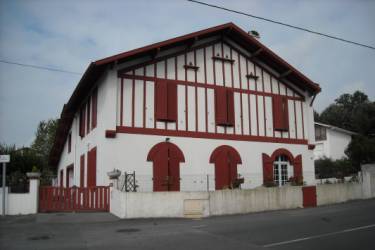
The Restaurant Larre of Marthe Mendiara.
This new route becomes very successful and 83 British, Commonwealth and American airmen and 6 Belgian and French agents will pass along the Larressore route in 21 cross-border passages between 21 September 1943 and 9 January 1944.
In October Marcel Roger (Max) joins Nothomb and they work together: 10 to 15 airmen will transit every week in late 1943. Some evader groups may have cycled by road to the rendezvous point with the Basque guides but later Pierre Elhorga prepared the route along the towpath following the River Nive, via Villefranque and Ustaritz, which is today a cycle path. The evaders leave Marthe Mendiara's Restaurant Larre along a path leading to the River Nive, 500 metres away. This path has since disappeared after the construction of a water purifying plant and an industrial area at this location. The Comet guides will be mainly Jean-François Nothomb and Marcel Roger.
Near Herauritz, the evaders leave the banks of the River Nive and take a road under cover of woods that brings them to the territory of Larressore while avoiding inhabited areas. The bikes are abandoned and taken away by the local baker, Martin Garat. The guides then lead their charges to a barn located on the communal border between the villages of Larressore and Espelette: the Mandochineko borda (the barn of farm Mandochinea). The barn today is in ruins and is overgrown with brambles and wild vegetation.
Within sight of this barn, but located within Espelette territory, is the Lapitza farm belonging to the Aguerre family and where the guide Baptiste Aguerre will farm after the end of the war.

The Lapitza farm and Mandochineko borda.
At nightfall, the Basque guides lead the airmen and the agents towards the Pyrenees and the Franco-Spanish frontier. The guides bring the evaders to Spain after a walk of approximately six hours. They skirt the village of Espelette, follow the Latsa valley and climb up to its source in the neighbourhood of Gaineko borda, between the peaks of Mondarrain and Atxulegi. From this pass, they walk down the valley of Larreko erreka (brook of Larre) until near the stone border marker (Mugari) #74. They then go upstream along the Haizagerriko erreka (brook of Haizagerri), cross the brook to reach the first safe house, Jauriko borda, 200 metres within Spain.
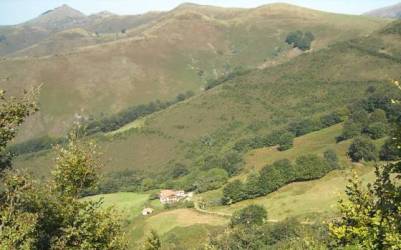
Jauriko borda seen from the Spanish side.
There the evaders are handed over to the Spanish family Mihura and rest a few hours. The first nine groups are advised to surrender to the Guardia Civile who transport the evaders taken to Urdax and then Irun before they are handed over to the British authorities. A few are arrested nearer to Elizondo. The next twelve groups are led further south in the daytime, around the peaks of Gorramakil and Gorramendi to another Navarre farm: Mortaleneko borda, located not far from the gap of Ispéguy in Erratzu. From there, they will reach San Sebastian by various means some taking another two or three additional days to reach that destination.
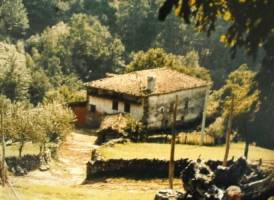
Mortaleneko borda in the 1960's.
THE CROSSING BY SOURAÏDE
The journey by Larressore is rapidly congested. But Pierre Elhorga knows other guides with knowledge of the mountains. One is Juanito Bidegain, a Spanish political refugee and cultivator at the Seme Enea farm in Bassussarry, on the road to Cambo. In March 1943, Bernard Maïsterrena had already provided to Juanito Bidegain some twenty young Frenchmen and two Belgians to pass. Bidegain had given them the same day to Jean-Baptiste Méhas of Souraïde for onward passage.
On 12 December 1943, the new team commence a series of 11 crossings of the Spanish border that will bring a total of 41 men to the British authorities in Guipúzcoa. Initially, Nothomb delivers the aviators to Bidegain but after his arrest in January 44, Pierre Elhorga becomes responsible for bringing them to the same venue, in some quarry in Bassussarry. Bidegain guides them on foot until the Mendigaraya farm situated to the North-west of Souraïde. Michel Echeveste resides here with his parents. Bidegain is the only person to know the location of Etcheveste’s hideout, where he escapes the German controls. His brother, Joseph Marie, is in hiding around Aïnhoa but helps him.
They pass the evaders into Spain to the house Apechemenda, near Dancharinea between Sare and Urdax. From there, they are guided further into Spain.
THE CHARACTERS
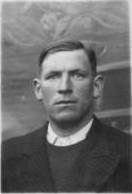 BAPTISTE AGUERRE
BAPTISTE AGUERRE
He is born at the Borrun Tehelmea farm at Espelette in September 1917. He marries Marie-Louise Etchegaray (born at Espelette in 1921), and is a cultivator at the house Latpitza at Espelette after the war. He was a conscript in 1938.
He is busy with the crossing of Frenchmen from relatives in Bayonne (about ten) with Pierre and Michel Etcheverry. Arrested on 2 June 1943, he escapes before his deportation to Germany. He is then contacted by Pierre Etchégoyen and becomes a guide of Pierre Elhorga for Jean-François Nothomb in the team of Pierre Etchegoyen, with brother Pierre and Jean Elizondo. His report identifies the destination in Spain: Jauriko borda.
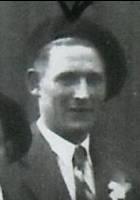 PIERRE AGUERRE
PIERRE AGUERRE
Born at the Borrun Tehelmea farm at Espelette in February 1916. He marries Marie Eyherabide (born at Larressore in 1921) and is a workman at the Uhart & Ilharreborda & Laronde Tanneries on Marines Avenue, Sabaltz Lane in Bayonne after the war. He was a conscript in 1939.
He is busy with the crossing of Frenchmen from relatives in Bayonne (about ten) with Pierre and Michel Etcheverry. He escaped being arrested. He is then contacted by Pierre Etchegoyen in August 1943, and becomes a guide of Elhorga for Jean Francois Nothomb with his brother Baptiste, Pierre Etchégoyen and Jean Elizondo. His report identifies the family Mihura in Spain.
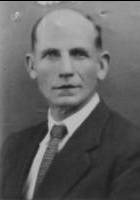 JUANITO BIDEGAIN
JUANITO BIDEGAIN
Juanito Bidegain was a Spanish political refugee and a cultivator at the Seme Enea farm in Bassussarry, on the road to Cambo. He lives with his mother Raimunda Elizagoyen and his two brothers Leon and Martin. He was born in Vera de Bidassoa in Spain in February 1900. Jean and Jeanne Elhorga, the son and daughter of Pierre, are warned to seek refuge with him if they ever see Germans at the school in Sutar.
Bidegain guides the aviators from Bassussary to Souraïde and hands them over to Michel Echeveste, somewhere around the Mendigaraya farm.
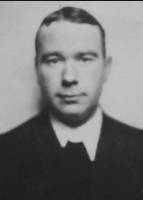 MICHEL ECHEVESTE
MICHEL ECHEVESTE
Born in Sare in June 1914, he performed his military service. In 1942, he guides isolated Frenchmen. He becomes a guide for Juanito Bidegain for 41 aviators from 12 December 1943 to 4 June 1944. He and his brother Joseph Marie use their farm, Mendigaraya, as a relay for the aviators.
On instructions from Juanito Bidegain, they bring the aviators to the house Apechemenda, and then they are guided further south. His parents are Joseph and Marie Miquelestorena living at the farm Mendigaraya in Souraïde.
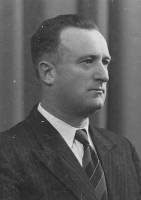 PIERRE ELHORGA
PIERRE ELHORGA
Born at Espelette in September 1897, he is 100% invalided after WWI. A retired customs officer of Cambo-les-Bains, he resides at the Sutar school in Anglet, where his wife Marie Bentaberry, born at Ispoure in 1902, is the head schoolteacher. He met Fernand De Greef in 1940 at the city hall, and the De Greef family in early 1941 at a reception of the mayor, Mr Dommain.
Elhorga is enlisted into Comet by Andrée De Jongh initially to help in the feeding of the evaders and subsequently to find and recruit guides for three new eastern routes. He puts her in touch with Mr Elizondo, of Sare. He guides Charles Morelle to Saint-Jean-Pied-de-Port from the demarcation line at Saint-Jean-le-Vieux towards Mauléon before the latter is arrested on May 6th, 1942.
Elhorga is a member of the group that conceives an escape plan for Andrée De Jongh from the Villa Chagrin prison in Bayonne, with Jean-François Nothomb, Rémy Larre and Jean Dassié at Marthe Mendiara’s Restaurant Larre.
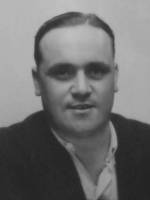 JEAN ELIZONDO
JEAN ELIZONDO
Born in Espelette in April 1920. He is an independent merchant of cattle at the Espondatea house in Espelette and marries Marie Arocena (born in September 1919) after the war. Pierre Elhorga introduces him to Andrée De Jongh in late 1942 for the new passage of Biddaray. He becomes a guide for Nothomb for the 89 aviators and agents passed through Larressore from 22 September 1943 to 9 January 1944. Pierre Etchegoyen recruited him with the Aguerres.
He participates later into the action of Battalion Vernet-Vidal under Captain Martinez from 1st May to 22 August 1944. He is the son of François and Eulalie Arotzasoua, residing in Hisparren, quarter Urcuruy.
PIERRE ETCHEGOYEN
Husband of Jeanne Ithurry (born in 1922 at Itxassou), he is born in Espelette in 1921 and is an independent animal merchant at the Chodieteya house in Espelette. Exempt from military service in 1941, he is transferred to the reserve. His parents are Hippolyte, born in 1888 at Ustaritz, and Marguerite Elhorga, born in 1888 at Espelette.
He has previously passed some Tunisians for business in France, received from Elizondo Senior. Elhorga (his uncle) recruited him as a guide by for Jean-Francois Nothomb at the end of August 1943. They met in the woods of Larressore, and then made contact with the Aguerres and Jean Elizondo to commence the Larressore route.
His report declares getting the “parcels” in the woods near Larressore and brought to the home of Garat by Nothomb (who determines the price), Marcel Roger, Elvire De Greef or Denise Houget. The evaders are then brought to Mandochineko borda and passed to the first house in Spain, Jauriko Borda. Etchegoyen paid Pierre and Baptist Aguerre and the farm in Spain for the food and transport up to Erratzu at Mortaleneko borda.
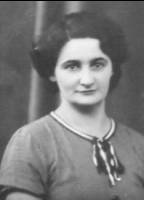 JEANNE MARTHE MENDIARA-VILLENAVE
JEANNE MARTHE MENDIARA-VILLENAVE
Born
in November 1905 at Saint-Martin de Gugane, Marthe Villenave is the
wife of Felix Antonio Mendiara, born in San Sebastian in November 1903,
who is a PoW in Germany.
From July 1943 onwards, most Comet airmen are accommodated in the bedrooms above Marthe Villenave’s “Restaurant Larre”, which is located on the road to Cambo and near Sutar school (Pierre Elhorga replaced her two nights). Elvire De Greef records 175 airmen, accommodated at Restaurant Larre, some staying as long as five days.
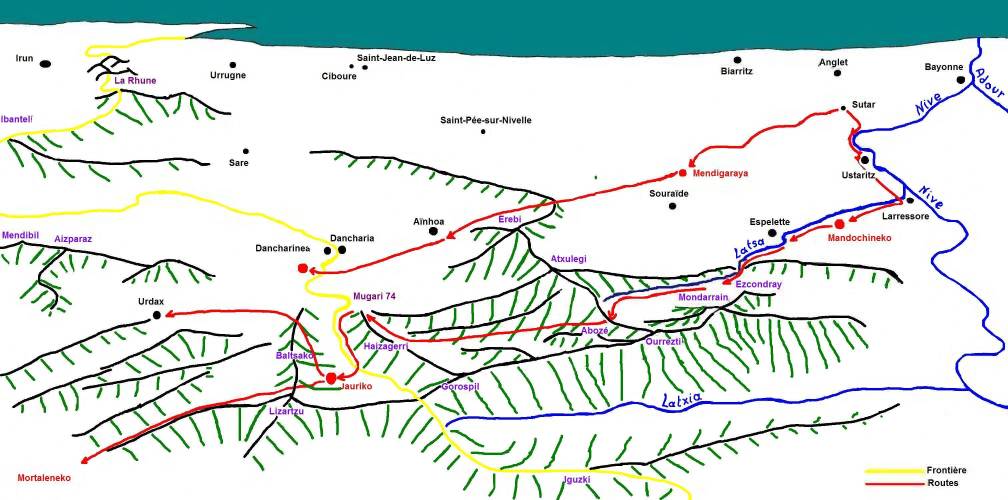
Overview of the crossing area.
